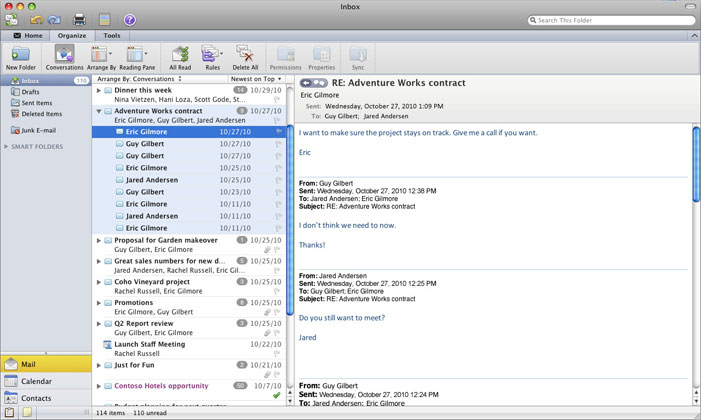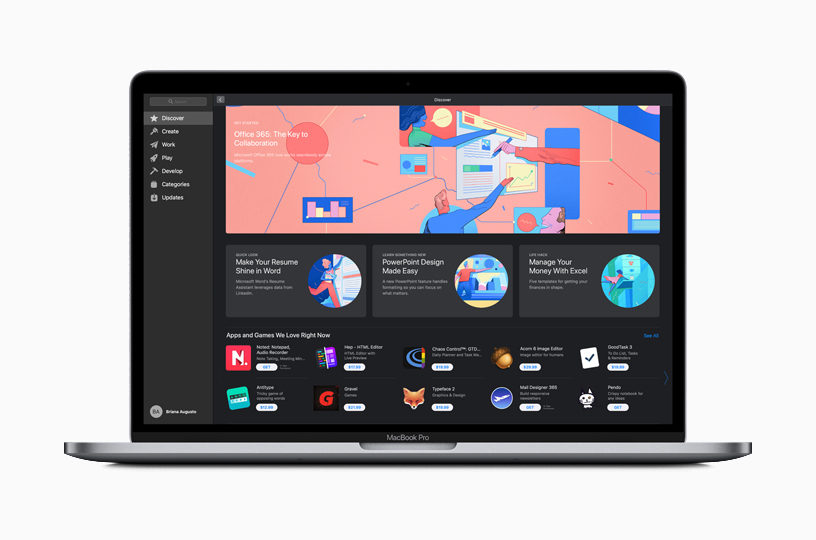Microsoft Outlook Mac Os App Store
When downloaded from the Mac App Store, Word, Excel, and PowerPoint require an Office 365 subscription to create and edit documents. To send and receive email, Outlook requires an Office 365 subscription. You can activate an existing Office 365 subscription, or use the in-app purchase option to start a new subscription. Microsoft Office 365 apps are now available in the Mac App Store You can get Word, Excel, PowerPoint, and other Office 365 apps and use your current subscription with them.
Applies to:Office for Mac
This article is for IT administrators and discusses frequently asked questions about the availability of Office from the Mac App Store, and the differences between downloading and distributing Office apps directly from Microsoft.
Starting in January 2019, the following Office applications are available for download from the Mac App Store:

- Microsoft Word
- Microsoft Excel
- Microsoft PowerPoint
- Microsoft Outlook
- Microsoft OneNote*
- Microsoft OneDrive*
* These apps were also available from the Mac App Store in previous years.
Make sure your Mac has a working internet connection, then: 1. Update Mac OS X. Open the App store and click on the Updates button. Install the updates. After, in any Office application go to the Help menu and choose Check for Updates to launch the AutoUpdate app. Let AutoUpdate install updates and then restart your Mac. Office 365 Commercial customers can get the new Outlook for Mac by accessing their Office 365 Portal, (Gear icon Office 365 Settings Software Outlook for Mac icon) or visiting the Software page Office 365 consumer subscribers can get the new Outlook for Mac by going to their My Account page. 2020-4-4 Excellent news for those who need to use Office apps on their Mac, with Apple announcing that Microsoft has made Office 365 available from the Mac App Store for the first time. That means that users can download Outlook, Excel, PowerPoint, OneNote, and everything that is part of the Office suite right from the App Store. 2020-4-5 Microsoft ได้ปล่อยแอป Office บน Mac App Store โดยผู้ใช้ Mac ต้องสมัคร Office 365 ก่อนจึงจะใช้ Word, Excel, PowerPoint และ Outlook ได้ Microsoft Office สำหรับ Mac เปิดให้ดาวน์โหลดแล้วบน Mac App Store ผู้ใช้ Mac สามารถ. 使用最新版本的 Outlook 家用版和商业版,通过整合在一起的电子邮件、日历和联系人进行联系并保持井然有序。 Outlook 可预见你的需求。旅行和账单支付可自动添加到你的日历,通过智能提醒,让你了然于.
What version of Office is available from the Mac App Store?
The Office apps available from the Mac App Store provide the very latest production version of Office on the Mac. Word, Excel, PowerPoint, and Outlook require an Office 365 subscription to activate. OneNote and OneDrive do not require an Office 365 subscription, but some premium features may require an Office 365 subscription. All apps are compatible with Office 365 subscription plans, such as Office 365 A3, Office 365 A5, Office 365 Enterprise E3, Office 365 Enterprise E5, and Office 365 ProPlus.
Note
Some Office 365 subscriptions don't include access to downloadable Office apps. For example, the Office 365 A1, Office 365 Enterprise E1, and Office 365 F1 plans. For more information, see Office 365 plans.
Can I use apps from the Mac App Store with my Volume License?
No. Perpetual licenses, including Office 2019 and Office 2016, are not supported with Office apps available from the Mac App Store. The Volume License (VL) Serializer is not compatible with these apps. Attempts to use a perpetual license with Mac App Store apps will cause the apps to enter reduced functionality mode.
How do I deploy Office apps from the Mac App Store to computers in my organization?
You need an enterprise mobility management (EMM) tool that supports either Apple's Volume Purchase Program (VPP), Apple Business Manager, or Apple School Manager. For example, Jamf Pro is compatible with these programs and can be used to deploy Office apps. Office supports managed distribution, which allows your Mobile Device Management (MDM) server to install Office even when the user does not have an Apple ID. Office apps cannot be distributed through redeemable codes.
While a consumer may acquire Office through the Mac App Store as a bundle with a single-click download, IT admins will need to deploy the individual apps.
When deployed through the Mac App Store, does Office behave differently, or provide less functionality?
Word, Excel, PowerPoint, Outlook, and OneNote provide the same end-user functionality regardless of how it is deployed. IT admins have traditionally deployed Office from Microsoft's Content Delivery Network (CDN), but now have the option of deploying from the Mac App Store.
The OneDrive app, when acquired from Microsoft's CDN, offers IT admins more deployment flexibility such as pre-enabling icon overlays and system access. When acquired from the Mac App Store, users will see additional prompts to enable this functionality.
The Office builds available from the Mac App Store are production builds and are usually updated on a monthly basis. The Office Insider program is not supported through the Mac App Store. If you wish to use the Insider Slow or Fast channels, you should continue to install Office apps from the Microsoft CDN.
Microsoft Teams and Skype for Business are not available through the Mac App Store and must be deployed from the Microsoft CDN.
How do Office updates occur?
When Office apps are deployed through the Mac App Store, it is the sole responsibility of the App Store to keep those apps up-to-date. Conversely, apps deployed from Microsoft's CDN are updated through the Microsoft AutoUpdate (MAU) tool. Content caching services in macOS can be used (and is highly recommended) to optimize both the installation and update process of Office apps acquired through the Mac App Store.
The download size of monthly update packages is the same, regardless of whether the CDN or Mac App Store is used for deployment.
Can I convert an existing CDN-based Office installation to Mac App Store?
If a user launches the App Store app on their Mac, they may see that Office apps are available for download even though Office is already installed from Microsoft's CDN. Depending upon the currently installed Office build, and the build available in the Mac App Store, the existing app may or may not get overwritten. For example, if the build of Office currently installed is newer than what is available from the Mac App Store (such as an Insider build), it will not be overwritten if the user chooses to download the Mac App Store build.
There is no automated process for performing a CDN to Mac App Store conversion. Depending on your EMM's capabilities, you may be able to orchestrate the process through a script. The high-level steps for each Mac are as follows:
- Close all Office apps
- Remove the Office apps from the /Applications folder
- Remove the Office entries from the keychain
- Remove the Office package registrations (
pkgutil --forget) - Trigger the MDM server to install the Office apps (such as
jamf recon)
While CDN-based installations of Office can utilize the bandwidth-optimized suite installer, which is approximately 1.8 GB in size, the total size of the same apps when deployed through the Mac App Store is approximately 4 GB.
How can I tell if an Office app was downloaded from the Mac App Store?
Mac Os Versions
- Open Finder, and navigate to the Applications folder
- Locate the Office app (such as Microsoft Outlook.app), control-click, and choose Show Package Contents
- Navigate into the Contents folder
- If a folder named
_MASReceiptis present, the app was downloaded from the Mac App Store
How do I manage Office policies and preferences with apps downloaded from the Mac App Store?
Word, Excel, PowerPoint, Outlook, and OneNote offer the same policies and preferences as their CDN-based counterparts. IT admins do not need to alter existing Configuration Profiles as the bundle ID for each app is unchanged.
Note
 Oct 30, 2008 Before you install this update, make sure that the Microsoft Office 2008 for Mac 12.1.3 Update is installed on your computer. To verify that you have installed this update, open any Microsoft Office 2008 application (for example, open Word), and then on the Word menu, click About Word. Oct 14, 2008 In the Office 2008 12.1.3 Update volume window, double-click the Office 2008 12.1.3 Update application to start the update process, and then follow the instructions on the screen. If the installation finishes successfully, you can remove the update installer from your hard disk. May 11, 2010 Microsoft Office for Mac 2008 may be the best pick for business users, with major updates to Word, Excel, PowerPoint, and Entourage. After a series of delays, Microsoft plans to release Office for Mac 2008 to brick-and-mortar and online stores on January 15, making this the first update in nearly four years. Apr 17, 2018 To verify that the Microsoft Office 2008 for Mac 12.1.0 Update is installed, follow these steps: On the Go menu, click Applications. Open the Microsoft Office 2008 folder, and then start any Office application (for example, start Word). On the Word menu, click About Word.
Oct 30, 2008 Before you install this update, make sure that the Microsoft Office 2008 for Mac 12.1.3 Update is installed on your computer. To verify that you have installed this update, open any Microsoft Office 2008 application (for example, open Word), and then on the Word menu, click About Word. Oct 14, 2008 In the Office 2008 12.1.3 Update volume window, double-click the Office 2008 12.1.3 Update application to start the update process, and then follow the instructions on the screen. If the installation finishes successfully, you can remove the update installer from your hard disk. May 11, 2010 Microsoft Office for Mac 2008 may be the best pick for business users, with major updates to Word, Excel, PowerPoint, and Entourage. After a series of delays, Microsoft plans to release Office for Mac 2008 to brick-and-mortar and online stores on January 15, making this the first update in nearly four years. Apr 17, 2018 To verify that the Microsoft Office 2008 for Mac 12.1.0 Update is installed, follow these steps: On the Go menu, click Applications. Open the Microsoft Office 2008 folder, and then start any Office application (for example, start Word). On the Word menu, click About Word.
OneNote does use a different bundle ID, and different management controls are available depending on how you obtain the app. For more information, see Deploy and configure the new OneDrive sync client for Mac.
Microsoft Outlook Mac Os App Store Login
It is highly recommended that IT admins set the OfficeAutoSignIn value to TRUE in the com.microsoft.office preferences domain. For new installations from the Mac App Store, this preference will bypass the first run dialogs that ask users if they wish to purchase a new Office 365 subscription. This will mitigate calls to the help desk in commercial environments as users can only activate an existing subscription.
